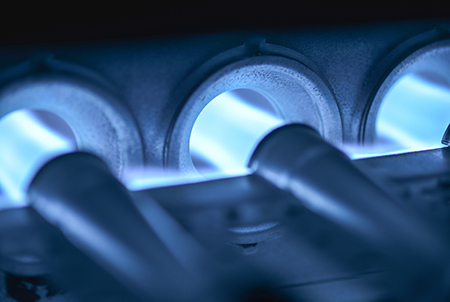
FINE-TUNING BOILER EFFICIENCY
To increase efficiency from commercial boilers Building Services Engineers must look beyond the existing BMS and boiler controls. Tony Willis, Technical Director, Sabien Technology explains
Most building services engineers and energy managers know that boiler dry cycling can occur with the vast majority of commercial boilers causing unnecessary energy use and carbon emissions. Unsurprisingly, a common assumption is that if the boilers are linked to a building management system or building energy management system (BMS/BEMS), with existing control strategies such as weather compensation and boiler sequencing etc, the issue of boiler dry cycling has already been addressed. However, this is a common misconception and is rarely the case. Therefore additional controls are required to address the problem.
A typical commercial boiler plant may have boiler sequencing in place that controls the required number of boiler/s to meet the current base loads for the building. However, boiler sequencing can only be truly effective if the standby boiler(s) (lag) is isolated from the main heating circuits; this should normally be done via automatic motorised valves (to hydraulically isolate heated water to the boilers not currently operating). Typically, in practice these valves are not installed or have been bypassed due to maintenance issues, which can lead to increased boiler standing losses (wasted heat) and cause the BMS sequencing to operate intermittently.
Typically, the BMS/BEMS will control the boilers’ required set points by monitoring water temperatures in the common flow and return boiler header circuits, measuring and responding to the overall blended temperatures from all of the boilers. Under most circumstances, it will not be monitoring the direct load profiles of each individual boiler under variable load conditions and it would therefore be very difficult, if not impossible, to identify which of the boilers are ‘dry cycling’, ‘short circuiting’ or ‘short cycling’ and the wasted heat/energy will remain undetected resulting in a lost opportunity to increase boiler efficiency and reduce costs.
Technically, it is possible to re-configure a BEMS to monitor individual boiler performance and attempt to control boiler dry cycling. However, the experience of several of our customers is that the cost of additional hardware and field wiring and writing a specific site strategy within the BMS programme greatly exceeds the cost of retrofit controls. Furthermore, such a ‘one-off’ solution is difficult to replicate across an estate and is not a tried and tested solution with a known track record.
There have also been attempts to address boiler dry cycling by introducing ‘demand control’ through the BEMS and clearly a boiler that is not enabled will be more efficient. However this is only the case if the boiler has been hydraulically isolated to avoid the boiler acting as a large radiator (standing losses i.e. heat losses from the boiler casing and flue) BMS demand control, enables the boilers to fire until the system’s demands e.g. domestic hot water, radiators, and air handling units etc. have all been satisfied. Unfortunately, in most buildings such loads are not typically satisfied simultaneously for any length of time. For the rest of the time there is a strong likelihood of boiler dry cycling occurring during transient loads.
So while a fully functional, correctly configured and regularly maintained BEMS can deliver good energy savings there is still scope for additional savings by retrofitting additional controls that address specific areas of wasted energy consumption.
In such cases it is vital that the selected retrofitted control does not conflict with the BMS/BEMS it should add to and fine tune what is already being achieved.
Harnessing modern technologies
Early attempts to tackle boiler dry cycling (some of which have re-emerged) were wholly unsatisfactory. For example, some increased the normal time delay between firing cycles but, as will be obvious to HVR readers, boilers work on temperature and not time. Simply holding a boiler off on a time delay will not be able to identify if the boiler is firing under true load conditions and will ultimately artificially lower the boiler set point and cause conflicts with other controls including the BMS.
Other unsatisfactory products reduced the boiler set points, allowing temperatures to fall in the spaces being heated again causing conflicts with the existing control BMS strategies.
However, our patented boiler load optimisation technology analyses each boiler’s flow and return temperatures every 10 seconds, and measures the decay of the flow and return every second. This provides a true individual boiler load profile and can differentiate between a genuine call for heat and one that is simply firing to replace the heat caused by boiler standing losses.
Furthermore, it recalculates the values every time the boiler reaches its required set point temperature, so it adapts to BMS/ optimiser variable set-points and does nothing to conflict with other existing controls.
Our experience of installing over 5,000 of our M2G boiler load optimisation controls is that such measures can deliver additional energy saving of 10%-25% with a payback of less than two years. This shows that, taking effective control of boiler dry cycling is an effective way to help building operators reduces their energy costs and carbon emissions without major capital investment.
However, it’s important to select the right retrofit controls. The key is to understand how they work (don’t be fooled by manufacturers’ jargon). Talk to others that have used them and be absolutely certain they won’t compromise comfort or the existing control strategy. Not all retro fit boiler controls work in the same way or deliver the same genuine energy savings.





